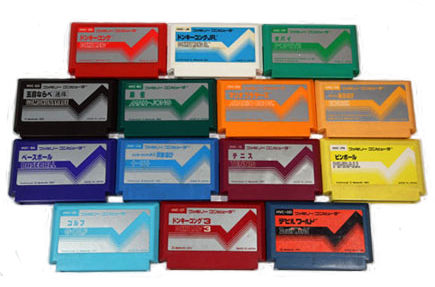Article
In the early days of the Family Computer, Nintendo Co., Ltd. released games with the same label design. Up to that point, Nintendo seemed to think that the best marketing strategy for their games was to keep the labels consistent in design; later on they began producing more creative label designs that varied for each game and often featured characters or scenes from the game.
The “pulse line” cartridges have a label showing the title of the game in Japanese (or Chinese, for Taiwanese or Hong Kong releases) and English. A set of lines, varying in thickness and following the common shape of a pulse line, stretches across the label from left to right. The color of the lines match the color of the plastic cartridge, with the exception of Pinball and Devil World.
There was more than one version of the pulse line label released for each game, one in Japan and one in Hong Kong. For instance, most of the games you’ll come across have “Family Computer” written on the upper portion of the label in Japanese, but on Taiwanese or Hong Kong cartridges, it’s written in English, like Baseball.
Below is a list of the 14 Japanese Famicom cartridges released with a pulse line, beginning in July 1983 with Donkey Kong and ending in October 1984 with Devil World.
In order of release: (1) Donkey Kong; (2) Donkey Kong Jr.; (3) Popeye; (4) Gomokunarabe; (5) Mah-Jong; (6) Mario Bros.; (7) Popeye English; (8) Baseball; (9) Donkey Kong Jr. Math; (10) Tennis; (11) Pinball; (12) Golf; (13) Donkey Kong 3; (14) Devil World.

